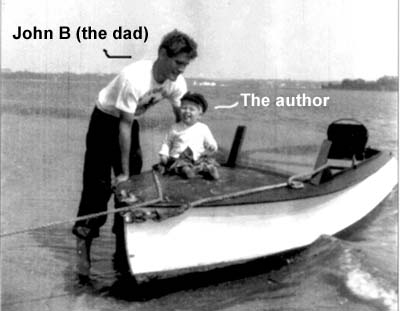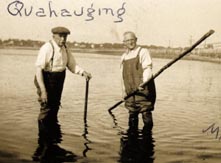|
FRESH STUFF DAILY |
|
|
||
|
|
||
|
|
||
|
SEE ALL SIGNED BOOKS by J. Dennis Robinson click here |
||
Page 2 of 2
I remember watching my mother's father Clement and the other men slitting open the colorful serrated mouths of the scallops, jerking the top shells back, and slicing the wet scallop hinge meat out as the pitiful oozy animals dropped into the sand. They would do that, flicking the meat into a pan of water and flipping the shells into the heap as if the whole process was a single movement. Years later my brother Brian discovered a 5,000 year old Indian skeleton buried under the clam flats of Seabrook, NH. The dusty outline of the bones remained, he said, because the burial lay beneath a great mound of discarded shells. The limestone, you see, had preserved it. That's when I first really understood the power of clams. We scalloped in October, when scallop season was on. Earlier it was quahogs, or "little necks", and then clams, incredible awesome long black-necked clams that we found by running along the stinky flats at low tide in our bare feet until one would squirt its telltale stream into the air. Then we fell to our knees scooping furiously in the black mud with the biggest shell we owned and harvested the beast. If the shell fit inside the brass ring my father always carried, we'd fling the seed clam back into the ocean. The "keepers" went into the bucket, a bushel was legal, and the bucket went to camp. I don't make clam chowder often now, but I do make the best. We three boys were spoiled, my mother says, by growing up among the freshest most tender clams. Even around here, you can hardly find them any more. When you've feasted on nectar, its hard to settle for fruit juice. Aunt Grace, my mother's sister who still has the camp at Gray Gables just over the Bourne Bridge at the Cape, still keeps her shellfish license. She likes to let the freshly-dug long necks work out the grit, and leaves them in salt water in the sink all night with corn meal which the clams ingest.
I almost got into a fist fight with a waiter in Portsmouth two decades back when he told me the restaurant's clam chowder was "home made." It took a few days of stalking the trash cans in the alley, but eventually I found what I was looking for and marched back into the restaurant with a massive can of Snow's Clam Chowder in hand. The waiter admitted they used tinned chowder "as a base." I went nuts. "What do you add -- salt?" I sneered. Real chowder requires fresh clams, preferably dug by you within hours of eating. The best come from Ipswich, MA. The worst come in those little tins from Thailand.You want to grind only the big tougher New England clams and keep the smaller tasty ones whole. Real clam chowder is crammed full of obscene little clams with their necks and stomachs intact. It is not interspersed with tiny pinkish flecks of rubbery shellfish matter that look and taste like chopped pencil eraser. That's quahog chowder. In real clam chowder The potatoes and onions are cooked in the broth of the clams which you first steam open. Great grampa Scott had a heart condition, greased the skillet with pork fat, and lived to be 89. I use bacon. You do not add spices beyond pepper and salt. You do not add tomatoes, colorful vegetables, sprigs of this or that. You do not add fish, things that look like fish, or other shellfish, especially lobster. You only add the milk at the very last minute and you never never put in a thickener of any kind. If your spoon stands up in the mixture like a thick frappe, give it to the dogs. There is an eccentric branch of our family that occasionally uses cream instead of milk. I love them, but they're wrong. Clam chowder is thin and gray and milky, the way God intended. It is all about clams and everything in it is there to honor the clam. Clams are primal things, made of mud remind us where we come from and where we will all end up. I never met great grampa Scott, but I know he'd agree. His recipe was first printed in the 1930s, in a cookbook to raise money for the Upton, Massachusetts Congregational Church. After he retired, Grampa Scott moved to Upton. My mother and father attended that church and were married there years later. I was baptized there in what felt to me, at the time, like a bowl of warm chowder. Our family is short on heirlooms. We've consistently managed not to accumulate wealth and property. We have no titles, major medals, patents, presidential citations, framed portraits or fine crystal. We don't even have great furniture. But long after such trinkets are gone to dust and rust, people who look uncomfortably like us will be living long lives somewhere near the ocean making the nations’ s best chowder. Copyright © 2005 by J. Dennis Robinson. All rights reserved. Originally published online in 1998. Not to be reproduced in whole or in part without written permission.
Please visit these SeacoastNH.com ad partners.
News about Portsmouth from Fosters.com |
| Tuesday, April 23, 2024 |


|
Copyright ® 1996-2020 SeacoastNH.com. All rights reserved. Privacy Statement
Site maintained by ad-cetera graphics

 HISTORY
HISTORY




 There are a thousand ways to make clam chowder wrong. I've tasted so many, even at the great chowder festivals they hold around here each year. where hundreds of gallons of less-than-perfect mixtures seem to please the crowds. I smile. Not bad, I say, but I'm just being polite. If you aren't related to me, you don't make chowder.
There are a thousand ways to make clam chowder wrong. I've tasted so many, even at the great chowder festivals they hold around here each year. where hundreds of gallons of less-than-perfect mixtures seem to please the crowds. I smile. Not bad, I say, but I'm just being polite. If you aren't related to me, you don't make chowder.














